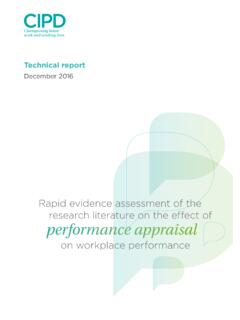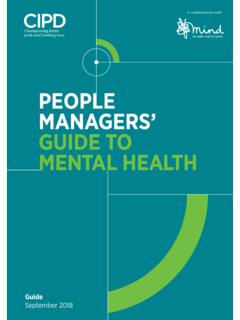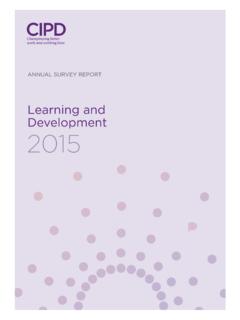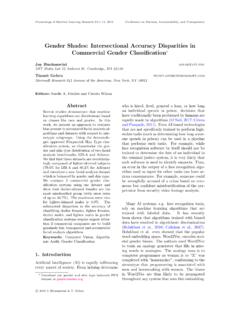Transcription of CREATING LEARNING CULTURES - CIPD
1 Report April 2020 Assessing the evidenceCREATING LEARNING CULTURES The CIPD is the professional body for HR and people development. The registered charity champions better work and working lives and has been setting the benchmark for excellence in people and organisation development for more than 100 years. It has more than 150,000 members across the world, provides thought leadership through independent research on the world of work, and offers professional training and accreditation for those working in HR and LEARNING and LEARNING CULTURES : assessing the evidenceAcknowledgementsThis report was written by Mel Green and Jake Young at the CIPD. We d like to thank our colleagues at the CIPD for their helpful feedback on this report. In addition, we d like to thank the CIPD L&D advisory group members and Jude Kittley from BAE Systems for their invaluable input as we scoped this project. Publication informationWhen citing this report, please use the following citation:CIPD.
2 (2020) CREATING LEARNING CULTURES : assessing the evidence. London: Chartered Institute of Personnel and LEARNING CULTURES : assessing the evidenceContents Summary 2 Introduction 3 What is a LEARNING culture ? 5 making the case for taking a systemic approach to LEARNING 9 Barriers to embedding LEARNING 11 How can organisations embed LEARNING in their workplace? 12 Conclusion 14 Appendix 152 CREATING LEARNING CULTURES : assessing the evidence1 SummaryWorkplaces need to invest in the LEARNING and development of their workforce to stay future-fit in a complex and competitive world of work. CREATING a supportive environment for LEARNING is an important part of ensuring employees and the wider organisation have the right capabilities to adapt and respond to challenges in an agile and effective CIPD s Professionalising LEARNING and Development report found that 98% of LEARNING and development (L&D) practitioners wish to develop a positive culture for LEARNING , but only 36% feel like they ve developed one.
3 A key question is, therefore: how can L&D practitioners take action to embed LEARNING into their organisation s day-to-day practice? In this report, we explore the evidence on what a LEARNING culture is, what the benefits are, and what practical steps professionals can take to support LEARNING . What is the definition of a LEARNING culture ?Our review of the scientific evidence found that there are several definitions of LEARNING culture , including related concepts such as the LEARNING organisation and LEARNING climate. While there is no unifying definition or theory of LEARNING culture , there are several common concepts that can be found in many of the definitions: supporting individual LEARNING and transformation, and allowing this knowledge to shape strategy and process encouraging teams to learn and reflect on their work and proactively influence strategy and process change a willingness to learn and improve from the wider organisation and key LEARNING culture a useful term or concept?
4 culture is a broad term, and as a result it is difficult to define targeted actions or practices that work. There is evidence to suggest that LEARNING culture is linked to outcomes such as job satisfaction and motivation for LEARNING . However, there s less evidence on how to create a LEARNING culture and what its long-term impact might be. Recommendations: what should L&D professionals do?Instead of concentrating on CREATING a new culture for LEARNING , we recommend that L&D professionals at all levels reframe LEARNING culture as the environment for LEARNING . They can then provide guidance on tangible organisational practices and behaviours, and use the factors that underpin LEARNING culture as a framework to evaluate their LEARNING LEARNING to be truly embedded within the business, L&D professionals should evaluate the current LEARNING environment in place in their organisation and consider taking action at an organisational, team and individual level.
5 We highlight key recommendations at each level below. Organisational learningBusinesses need structures and systems in place to support LEARNING , as well as a shared vision for LEARNING and transformation. L&D professionals should: Work with leaders to define and communicate a vision for LEARNING and transformation, clearly linked to organisational objectives. Evaluate current systems for knowledge management and LEARNING . Consider whether there are appropriate channels in place to allow individual and team LEARNING and reflection to feed into organisational decision - making . Summary33 CREATING LEARNING CULTURES : assessing the evidenceIntroduction Consider whether dialogue, challenge and reflection are embedded into the organisation s approach. If not, consider how reflection and feedback can be encouraged as part of day-to-day activities. Examine whether individuals have an appropriate degree of voice and LEARNING Teams are a key place where social LEARNING and dialogue can occur.
6 Managers have an important role to play in ensuring that their employees also have the relevant support for LEARNING . L&D professionals can: Help line managers understand the key role they play in supporting LEARNING , whether this is formal or informal. Support managers to prioritise time and resources for formal and informal LEARNING . Build support for LEARNING and development into management objectives. Encourage line managers to be role models, to demonstrate how LEARNING is part of everyone s role, and share their learnings in their team training or encourage reflection as part of project LEARNING LEARNING needs to take place in a supportive environment that allows employees to apply their LEARNING . L&D professionals should engage with employees to: Consistently communicate LEARNING opportunities across the organisation. Highlight everyone s role in organisational and team LEARNING how does individual continuous LEARNING benefit individuals, their team, and the wider organisation?
7 Consider how opportunities to reflect and share on LEARNING can be used to follow up formal training, or be encouraged as part of individual development. Provide different types of LEARNING that appeal to a range of learners and allow employees to build their LEARNING pathway within an organisational Introduction The LEARNING imperativeMany organisations today operate in a complex and highly competitive environment and rely heavily on access to high-quality skilled labour. Successful firms know that a skilled and developed workforce is key to delivering organisation outcomes. Recruiting, developing and retaining the right skills is an important element of people practice. To remain relevant in a challenging labour market, organisations must think strategically about how they invest in and develop human capital: the knowledge, skills and abilities of the workforce. Several challenges and trends in the wider world of work are shaping organisations today.
8 The COVID-19 pandemic has had an unprecedented impact on the way businesses operate, leading organisations to change where they work and also consider how they work and the services they offer. Many organisations have had to upskill or reskill staff quickly, owing to redeployment, or to support staff needing to work remotely. The ability to learn, adapt and continuously improve is vital in the face of such a challenge. Digital tools and innovative processes are vital as businesses navigate a complex landscape. 4 CREATING LEARNING CULTURES : assessing the evidenceIntroductionIn the skills and LEARNING space the rising role of technology and automation is a key driver of change. The implementation of technology that is augmenting roles, rather than replacing them, means that employees need support and upskilling to make effective use of new In knowledge-based sectors, such as financial services or pharmaceuticals, upskilling is also often more cost-effective than recruiting, especially given that many businesses struggle to fill specialist skilled This requires employer investment in training and LEARNING , and recognition that this is imperative for organisations to stay future-fit.
9 However, fewer than half (47%) of UK employees agree that their job offers good opportunities to develop their skills,3 and case study research into the implementation of new technologies in the workplace suggests that LEARNING provision is often not fit for purpose when it comes to new It s also not just about formal LEARNING informal and social LEARNING are increasingly important. Many employees want to choose how and when they Again, this requires organisational support and resource for LEARNING whether building time in for LEARNING or facilitation of informal, social and digital LEARNING . Importantly, businesses also need to consider how they harness individual knowledge and LEARNING to continually improve business processes and employee skills. research suggests that workplace autonomy and good-quality line management has declined in recent This means employees may not be getting the support they need to use their LEARNING to suggest business improvements, which can have a negative impact on productivity.
10 While formal and informal LEARNING is key for organisations to adapt, individual LEARNING is not the norm in every organisation, and businesses do not always support this LEARNING and use it to continuously improve the way they do a culture for learningTo support LEARNING at an individual and organisational level, organisations need to create an environment that embeds LEARNING into the way they do things. This is often referred to as LEARNING culture . Recent research identifies that organisations in which LEARNING has a deep impact on key behaviours and is supported by LEARNING interventions and programmes experience better growth, transformation, productivity and CREATING a supportive environment for LEARNING is understandably a key concern for L&D professionals. The CIPD has recognised the importance of this wider cultural support for LEARNING in the new CIPD Profession Map, by calling out LEARNING culture in the L&D specialist knowledge area.
















